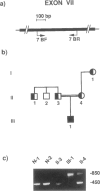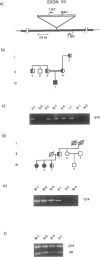Abstract
Missense mutations in the calcium-sensing receptor (CaR) gene have previously been identified in patients with familial hypocalciuric hypercalcemia (FHH) and neonatal severe hyperparathyroidism (NSHPT). We studied family members of a Nova Scotian deme expressing both FHH and NSHPT and found, by PCR amplification of CaR gene exons, that FHH individuals were heterozygous and NSHPT individuals were homozygous for an abnormally large exon 7. This is due to an insertion at codon 877 of an Alu-repetitive element of the predicted-variant/human-specific-1 subfamily. It is in the opposite orientation to the CaR gene and contains an exceptionally long poly(A) tract. Stop signals are introduced in all reading frames within the Alu sequence, leading to a predicted shortened mutant CaR protein. The loss of the majority of the CaR carboxyl-terminal intracellular domain would dramatically impair its signal transduction capability. Identification of the specific mutation responsible for the FHH/NSHPT phenotype in this community will allow rapid testing of at-risk individuals.
Full text
PDF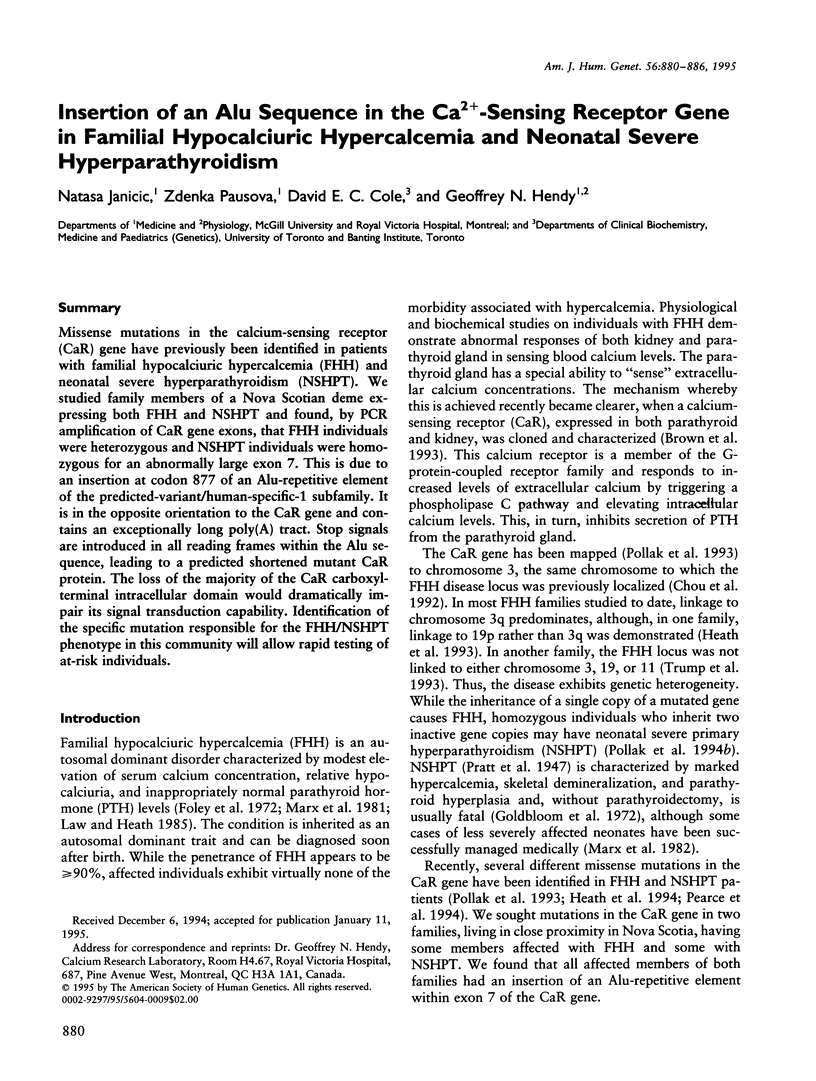
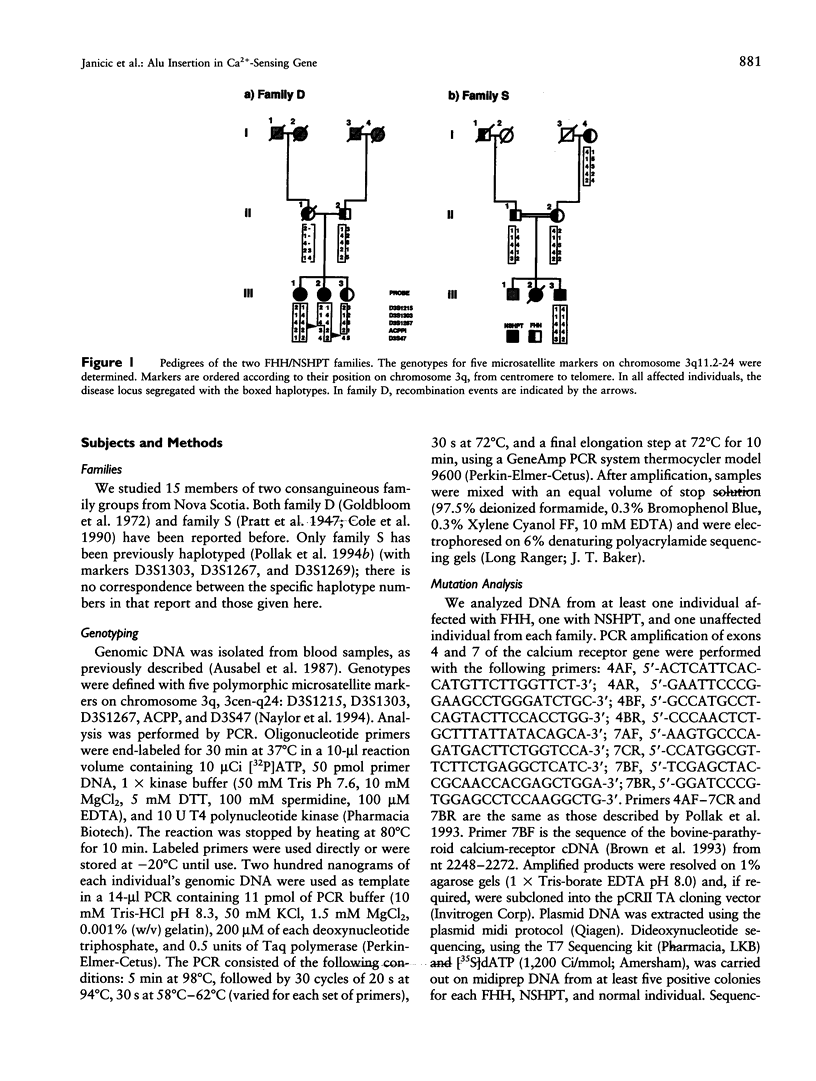
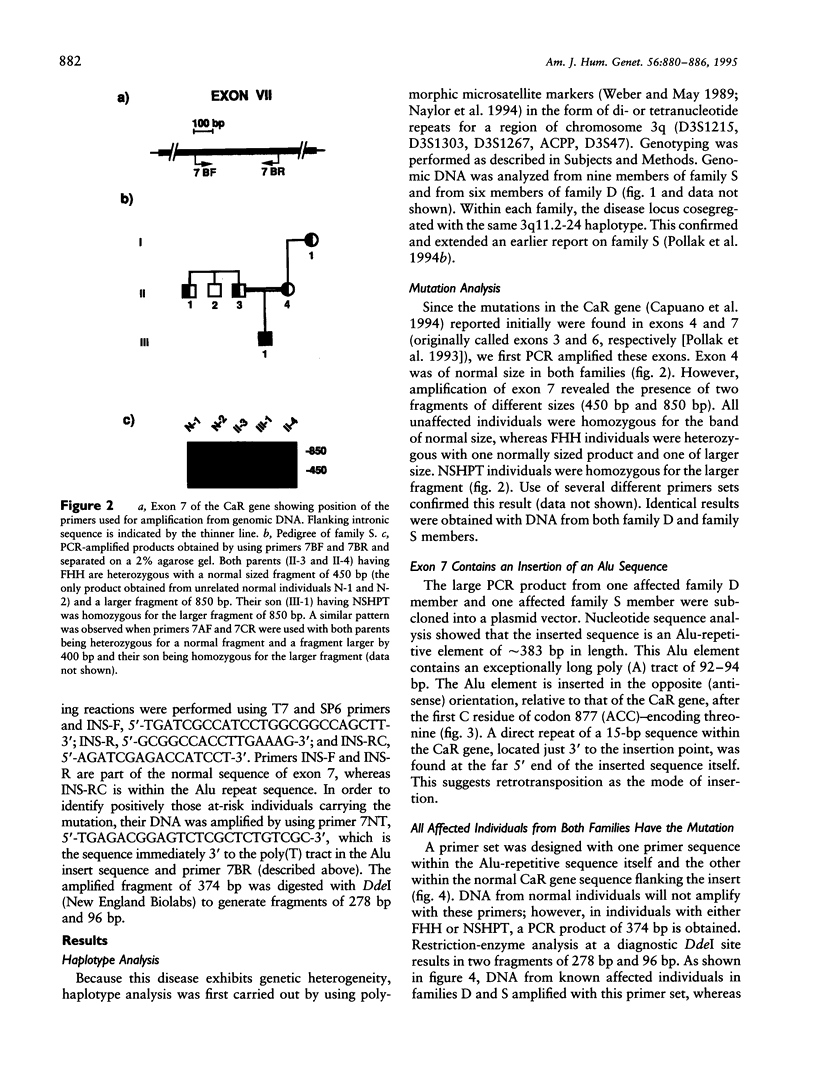
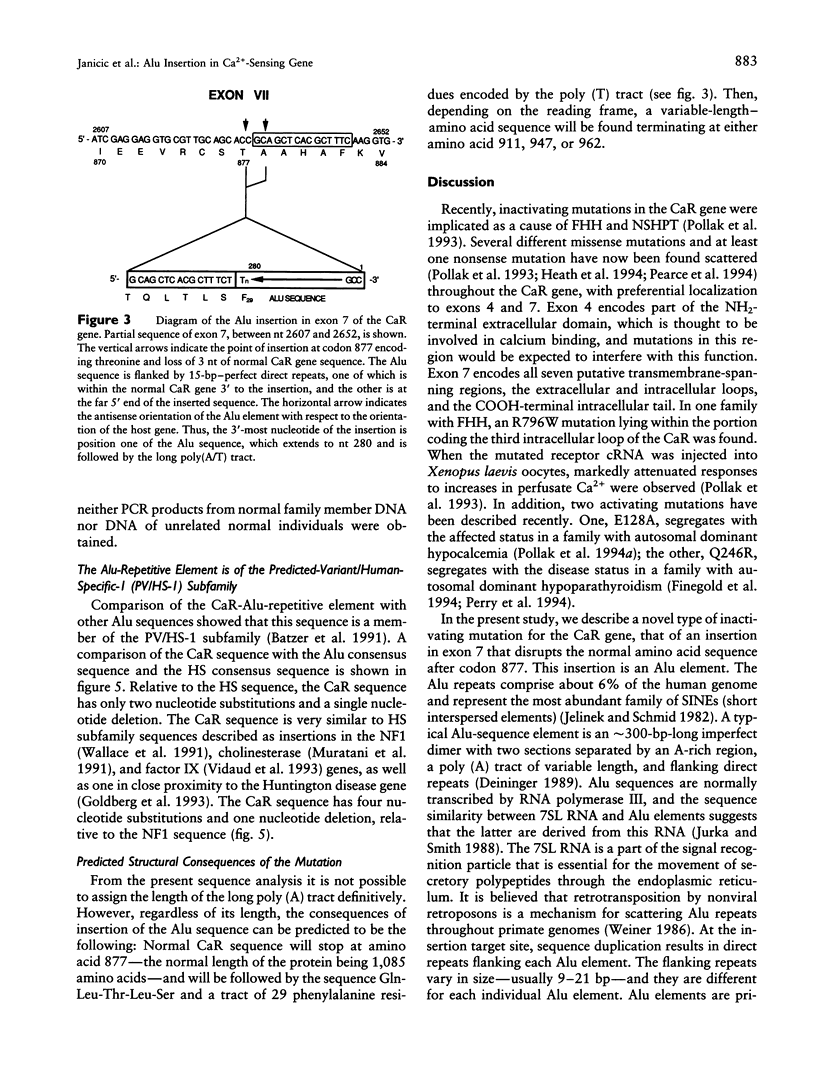
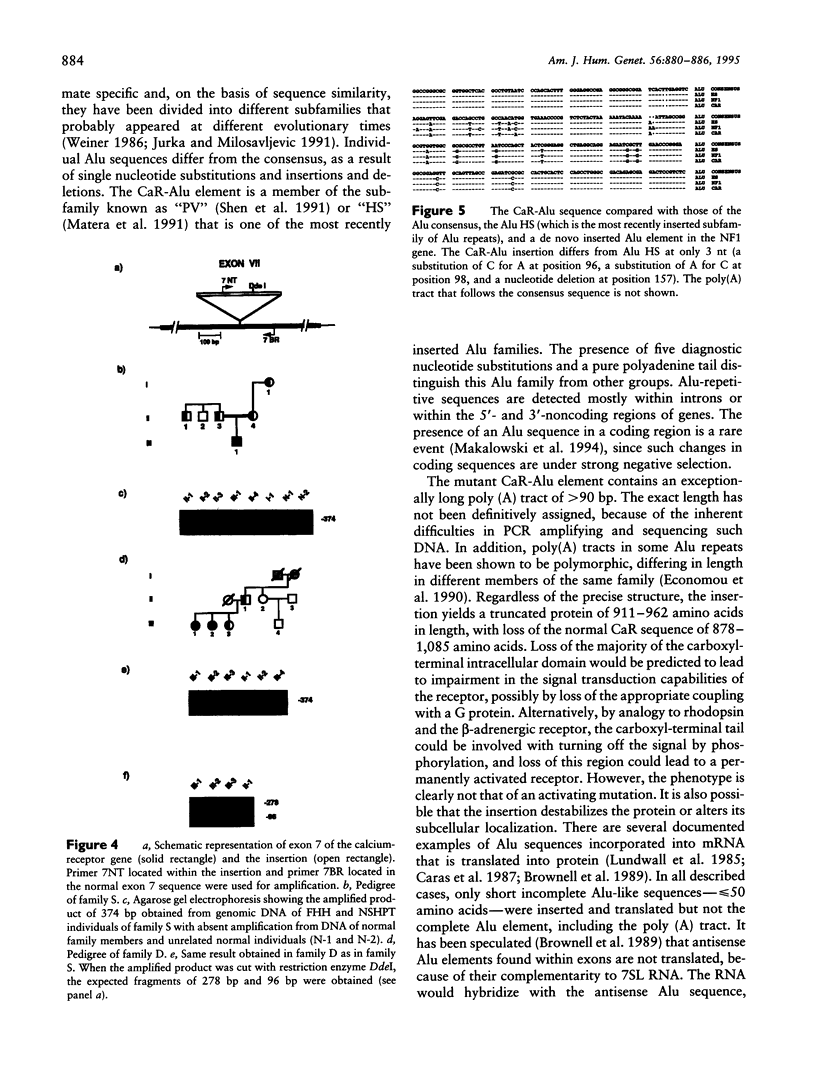
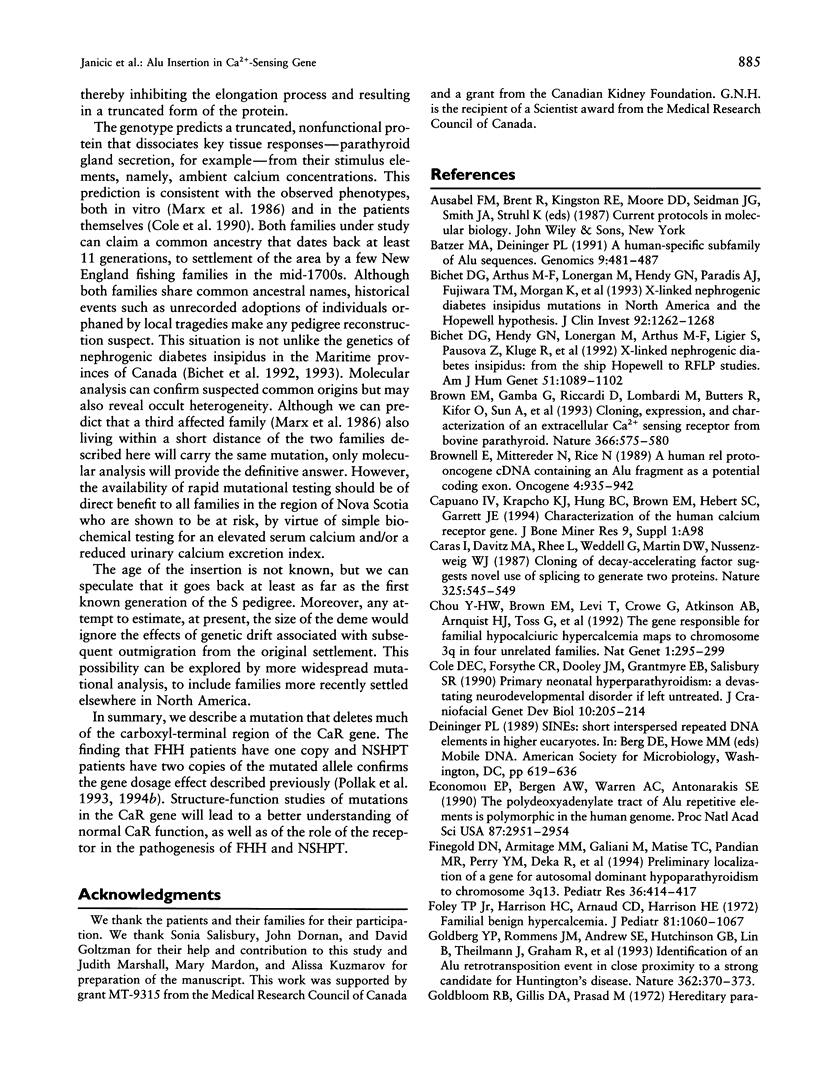
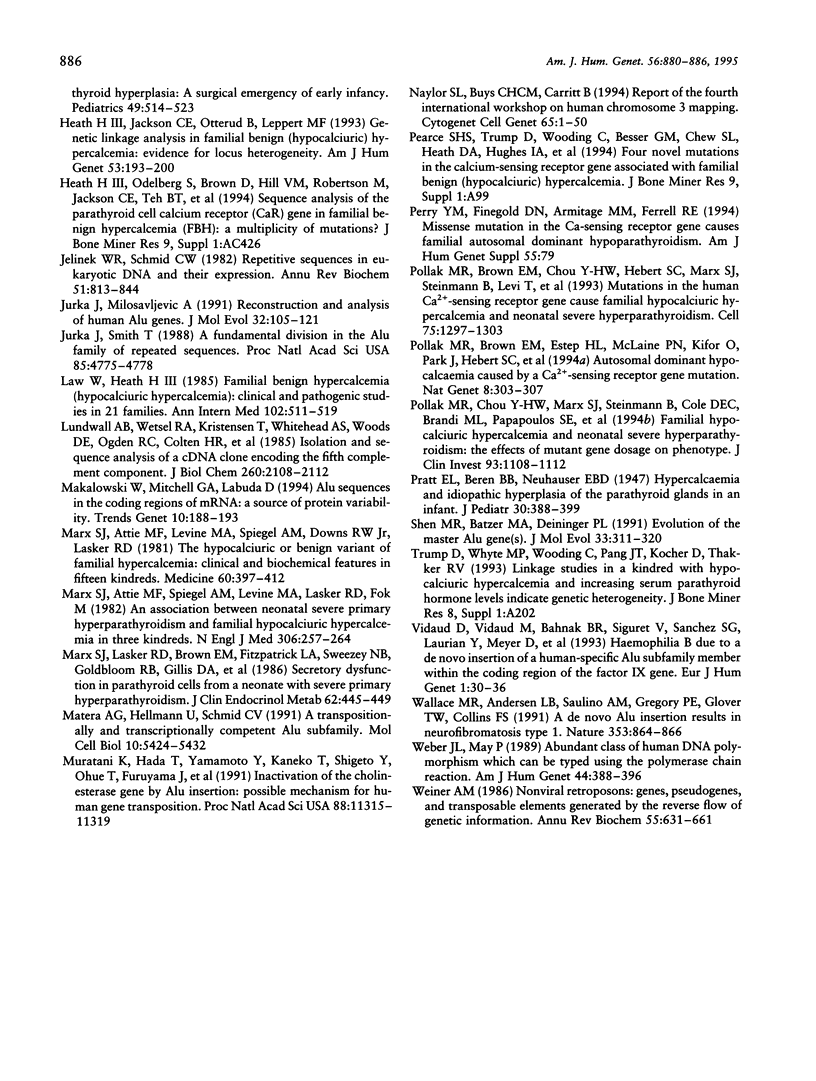
Images in this article
Selected References
These references are in PubMed. This may not be the complete list of references from this article.
- Batzer M. A., Deininger P. L. A human-specific subfamily of Alu sequences. Genomics. 1991 Mar;9(3):481–487. doi: 10.1016/0888-7543(91)90414-a. [DOI] [PubMed] [Google Scholar]
- Bichet D. G., Arthus M. F., Lonergan M., Hendy G. N., Paradis A. J., Fujiwara T. M., Morgan K., Gregory M. C., Rosenthal W., Didwania A. X-linked nephrogenic diabetes insipidus mutations in North America and the Hopewell hypothesis. J Clin Invest. 1993 Sep;92(3):1262–1268. doi: 10.1172/JCI116698. [DOI] [PMC free article] [PubMed] [Google Scholar]
- Bichet D. G., Hendy G. N., Lonergan M., Arthus M. F., Ligier S., Pausova Z., Kluge R., Zingg H., Saenger P., Oppenheimer E. X-linked nephrogenic diabetes insipidus: from the ship Hopewell to RFLP studies. Am J Hum Genet. 1992 Nov;51(5):1089–1102. [PMC free article] [PubMed] [Google Scholar]
- Brown E. M., Gamba G., Riccardi D., Lombardi M., Butters R., Kifor O., Sun A., Hediger M. A., Lytton J., Hebert S. C. Cloning and characterization of an extracellular Ca(2+)-sensing receptor from bovine parathyroid. Nature. 1993 Dec 9;366(6455):575–580. doi: 10.1038/366575a0. [DOI] [PubMed] [Google Scholar]
- Brownell E., Mittereder N., Rice N. R. A human rel proto-oncogene cDNA containing an Alu fragment as a potential coding exon. Oncogene. 1989 Jul;4(7):935–942. [PubMed] [Google Scholar]
- Caras I. W., Davitz M. A., Rhee L., Weddell G., Martin D. W., Jr, Nussenzweig V. Cloning of decay-accelerating factor suggests novel use of splicing to generate two proteins. Nature. 1987 Feb 5;325(6104):545–549. doi: 10.1038/325545a0. [DOI] [PubMed] [Google Scholar]
- Chou Y. H., Brown E. M., Levi T., Crowe G., Atkinson A. B., Arnqvist H. J., Toss G., Fuleihan G. E., Seidman J. G., Seidman C. E. The gene responsible for familial hypocalciuric hypercalcemia maps to chromosome 3q in four unrelated families. Nat Genet. 1992 Jul;1(4):295–300. doi: 10.1038/ng0792-295. [DOI] [PubMed] [Google Scholar]
- Cole D. e., Forsythe C. R., Dooley J. M., Grantmyre E. B., Salisbury S. R. Primary neonatal hyperparathyroidism: a devastating neurodevelopmental disorder if left untreated. J Craniofac Genet Dev Biol. 1990;10(2):205–214. [PubMed] [Google Scholar]
- Economou E. P., Bergen A. W., Warren A. C., Antonarakis S. E. The polydeoxyadenylate tract of Alu repetitive elements is polymorphic in the human genome. Proc Natl Acad Sci U S A. 1990 Apr;87(8):2951–2954. doi: 10.1073/pnas.87.8.2951. [DOI] [PMC free article] [PubMed] [Google Scholar]
- Finegold D. N., Armitage M. M., Galiani M., Matise T. C., Pandian M. R., Perry Y. M., Deka R., Ferrell R. E. Preliminary localization of a gene for autosomal dominant hypoparathyroidism to chromosome 3q13. Pediatr Res. 1994 Sep;36(3):414–417. doi: 10.1203/00006450-199409000-00024. [DOI] [PubMed] [Google Scholar]
- Foley T. P., Jr, Harrison H. C., Arnaud C. D., Harrison H. E. Familial benign hypercalcemia. J Pediatr. 1972 Dec;81(6):1060–1067. doi: 10.1016/s0022-3476(72)80232-4. [DOI] [PubMed] [Google Scholar]
- Goldberg Y. P., Rommens J. M., Andrew S. E., Hutchinson G. B., Lin B., Theilmann J., Graham R., Glaves M. L., Starr E., McDonald H. Identification of an Alu retrotransposition event in close proximity to a strong candidate gene for Huntington's disease. Nature. 1993 Mar 25;362(6418):370–373. doi: 10.1038/362370a0. [DOI] [PubMed] [Google Scholar]
- Heath H., 3rd, Jackson C. E., Otterud B., Leppert M. F. Genetic linkage analysis in familial benign (hypocalciuric) hypercalcemia: evidence for locus heterogeneity. Am J Hum Genet. 1993 Jul;53(1):193–200. [PMC free article] [PubMed] [Google Scholar]
- Jelinek W. R., Schmid C. W. Repetitive sequences in eukaryotic DNA and their expression. Annu Rev Biochem. 1982;51:813–844. doi: 10.1146/annurev.bi.51.070182.004121. [DOI] [PubMed] [Google Scholar]
- Jurka J., Milosavljevic A. Reconstruction and analysis of human Alu genes. J Mol Evol. 1991 Feb;32(2):105–121. doi: 10.1007/BF02515383. [DOI] [PubMed] [Google Scholar]
- Jurka J., Smith T. A fundamental division in the Alu family of repeated sequences. Proc Natl Acad Sci U S A. 1988 Jul;85(13):4775–4778. doi: 10.1073/pnas.85.13.4775. [DOI] [PMC free article] [PubMed] [Google Scholar]
- Law W. M., Jr, Heath H., 3rd Familial benign hypercalcemia (hypocalciuric hypercalcemia). Clinical and pathogenetic studies in 21 families. Ann Intern Med. 1985 Apr;102(4):511–519. doi: 10.7326/0003-4819-102-4-511. [DOI] [PubMed] [Google Scholar]
- Lundwall A. B., Wetsel R. A., Kristensen T., Whitehead A. S., Woods D. E., Ogden R. C., Colten H. R., Tack B. F. Isolation and sequence analysis of a cDNA clone encoding the fifth complement component. J Biol Chem. 1985 Feb 25;260(4):2108–2112. [PubMed] [Google Scholar]
- Makałowski W., Mitchell G. A., Labuda D. Alu sequences in the coding regions of mRNA: a source of protein variability. Trends Genet. 1994 Jun;10(6):188–193. doi: 10.1016/0168-9525(94)90254-2. [DOI] [PubMed] [Google Scholar]
- Marx S. J., Attie M. F., Levine M. A., Spiegel A. M., Downs R. W., Jr, Lasker R. D. The hypocalciuric or benign variant of familial hypercalcemia: clinical and biochemical features in fifteen kindreds. Medicine (Baltimore) 1981 Nov;60(6):397–412. doi: 10.1097/00005792-198111000-00002. [DOI] [PubMed] [Google Scholar]
- Marx S. J., Attie M. F., Spiegel A. M., Levine M. A., Lasker R. D., Fox M. An association between neonatal severe primary hyperparathyroidism and familial hypocalciuric hypercalcemia in three kindreds. N Engl J Med. 1982 Feb 4;306(5):257–264. doi: 10.1056/NEJM198202043060502. [DOI] [PubMed] [Google Scholar]
- Marx S. J., Lasker R. D., Brown E. M., Fitzpatrick L. A., Sweezey N. B., Goldbloom R. B., Gillis D. A., Cole D. E. Secretory dysfunction in parathyroid cells from a neonate with severe primary hyperparathyroidism. J Clin Endocrinol Metab. 1986 Feb;62(2):445–449. doi: 10.1210/jcem-62-2-445. [DOI] [PubMed] [Google Scholar]
- Matera A. G., Hellmann U., Schmid C. W. A transpositionally and transcriptionally competent Alu subfamily. Mol Cell Biol. 1990 Oct;10(10):5424–5432. doi: 10.1128/mcb.10.10.5424. [DOI] [PMC free article] [PubMed] [Google Scholar]
- Muratani K., Hada T., Yamamoto Y., Kaneko T., Shigeto Y., Ohue T., Furuyama J., Higashino K. Inactivation of the cholinesterase gene by Alu insertion: possible mechanism for human gene transposition. Proc Natl Acad Sci U S A. 1991 Dec 15;88(24):11315–11319. doi: 10.1073/pnas.88.24.11315. [DOI] [PMC free article] [PubMed] [Google Scholar]
- Naylor S. L., Buys C. H., Carritt B. Report and abstracts of the Fourth International Workshop on Human Chromosome 3 Mapping. Cytogenet Cell Genet. 1994;65(1-2):2–50. [PubMed] [Google Scholar]
- Pollak M. R., Brown E. M., Chou Y. H., Hebert S. C., Marx S. J., Steinmann B., Levi T., Seidman C. E., Seidman J. G. Mutations in the human Ca(2+)-sensing receptor gene cause familial hypocalciuric hypercalcemia and neonatal severe hyperparathyroidism. Cell. 1993 Dec 31;75(7):1297–1303. doi: 10.1016/0092-8674(93)90617-y. [DOI] [PubMed] [Google Scholar]
- Pollak M. R., Brown E. M., Estep H. L., McLaine P. N., Kifor O., Park J., Hebert S. C., Seidman C. E., Seidman J. G. Autosomal dominant hypocalcaemia caused by a Ca(2+)-sensing receptor gene mutation. Nat Genet. 1994 Nov;8(3):303–307. doi: 10.1038/ng1194-303. [DOI] [PubMed] [Google Scholar]
- Pollak M. R., Chou Y. H., Marx S. J., Steinmann B., Cole D. E., Brandi M. L., Papapoulos S. E., Menko F. H., Hendy G. N., Brown E. M. Familial hypocalciuric hypercalcemia and neonatal severe hyperparathyroidism. Effects of mutant gene dosage on phenotype. J Clin Invest. 1994 Mar;93(3):1108–1112. doi: 10.1172/JCI117062. [DOI] [PMC free article] [PubMed] [Google Scholar]
- Shen M. R., Batzer M. A., Deininger P. L. Evolution of the master Alu gene(s). J Mol Evol. 1991 Oct;33(4):311–320. doi: 10.1007/BF02102862. [DOI] [PubMed] [Google Scholar]
- Vidaud D., Vidaud M., Bahnak B. R., Siguret V., Gispert Sanchez S., Laurian Y., Meyer D., Goossens M., Lavergne J. M. Haemophilia B due to a de novo insertion of a human-specific Alu subfamily member within the coding region of the factor IX gene. Eur J Hum Genet. 1993;1(1):30–36. doi: 10.1159/000472385. [DOI] [PubMed] [Google Scholar]
- Wallace M. R., Andersen L. B., Saulino A. M., Gregory P. E., Glover T. W., Collins F. S. A de novo Alu insertion results in neurofibromatosis type 1. Nature. 1991 Oct 31;353(6347):864–866. doi: 10.1038/353864a0. [DOI] [PubMed] [Google Scholar]
- Weber J. L., May P. E. Abundant class of human DNA polymorphisms which can be typed using the polymerase chain reaction. Am J Hum Genet. 1989 Mar;44(3):388–396. [PMC free article] [PubMed] [Google Scholar]
- Weiner A. M., Deininger P. L., Efstratiadis A. Nonviral retroposons: genes, pseudogenes, and transposable elements generated by the reverse flow of genetic information. Annu Rev Biochem. 1986;55:631–661. doi: 10.1146/annurev.bi.55.070186.003215. [DOI] [PubMed] [Google Scholar]



